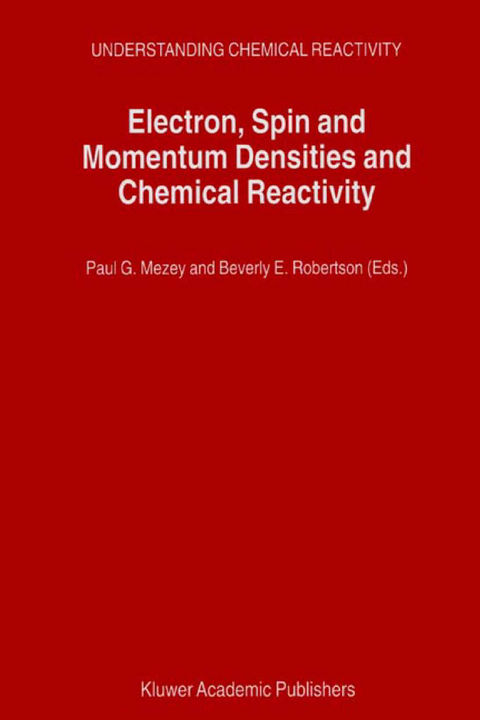
Electron, Spin and Momentum Densities and Chemical Reactivity
Springer-Verlag New York Inc.
978-1-4020-0413-1 (ISBN)
The electron density of a non-degenerate ground state system determines essentially all physical properties of the system. This statement of the Hohenberg–Kohn theorem of Density Functional Theory plays an exceptionally important role among all the fundamental relations of Molecular Physics. In particular, the electron density distribution and the dynamic properties of this density determine both the local and global reactivities of molecules. High resolution experimental electron densities are increasingly becoming available for more and more molecules, including macromolecules such as proteins. Furthermore, many of the early difficulties with the determination of electron densities in the vicinity of light nuclei have been overcome. These electron densities provide detailed information that gives important insight into the fundamentals of molecular structure and a better understanding of chemical reactions. The results of electron density analysis are used in a variety of applied fields, such as pharmaceutical drug discovery and biotechnology. If the functional form of a molecular electron density is known, then various molecular properties affecting reactivity can be determined by quantum chemical computational techniques or alternative approximate methods.
Maximum Entropy charge density studies: Bayesian viewpoint and test applications.- Reliability of charge density distributions derived by the maximum entropy method.- Maximum entropy reconstruction of spin densities involving non-uniform prior.- Transferability, adjustability, and additivity of fuzzy electron density fragments.- Beyond the local-density approximation in calculations of Compton profiles.- Interaction energy and density in the water dimer. A quantum theory of atoms in molecules: insight on the effect of basis set superposition error removal.- Topological analysis of X-ray protein relative density maps utilizing the eigenvector following method.- The number of independent parameters defining a projector: proof in matrix representation and resolution of previously conflicting arguments.- Kinetic equation, optical potential, tensor theory and structure factor refinement in high-energy electron diffraction.- ‘Compton microscope effect’?: image of intra-unit-cell atom theoretically observed in compton B(r)-function.- New light on electron correlation in simple metals: inelastic X-ray scattering results vs. current theoretical treatment.- The measurement of spectral momentum densities of solids by electron momentum spectroscopy.- Accurate structure factor determination using 100 keV synchrotron radiation.- Charge density data from CCD detectors.- Recent studies in magnetisation densities.- Magnetisation densities and polarised neutron diffraction: optimised flipping ratio measurements.- Concerning the magnetisation density in magnetic neutron scattering experiments.- A wave function for beryllium from X-ray diffraction data.- Spin density in interacting nitronyl nitroxide radicals.- Electrostatic potential of a new angiotensin II receptor antagonist fromX-ray diffraction and ab initio calculations.- Hat matrix and leverages in charge density refinements: example of atomic net charges determination in a natural zeolite, the scolecite.- The ? decay in anapole crystal.- Three-dimensional reconstruction of electron momentum densities and occupation number densities of Cu and CuAl alloys.- X-ray and neutron studies of cis-enol systems at liquid helium temperatures.- Effect of pressure on the Compton scattering of metallic Li.- Magnetic Compton profile in uranium chalcogenide compounds UX (X=Se, Te).
| Erscheint lt. Verlag | 30.11.2001 |
|---|---|
| Reihe/Serie | Understanding Chemical Reactivity ; 21 |
| Zusatzinfo | X, 334 p. |
| Verlagsort | New York, NY |
| Sprache | englisch |
| Maße | 155 x 235 mm |
| Themenwelt | Naturwissenschaften ► Chemie ► Physikalische Chemie |
| Naturwissenschaften ► Geowissenschaften ► Mineralogie / Paläontologie | |
| Naturwissenschaften ► Physik / Astronomie ► Atom- / Kern- / Molekularphysik | |
| Naturwissenschaften ► Physik / Astronomie ► Festkörperphysik | |
| Technik ► Maschinenbau | |
| ISBN-10 | 1-4020-0413-3 / 1402004133 |
| ISBN-13 | 978-1-4020-0413-1 / 9781402004131 |
| Zustand | Neuware |
| Haben Sie eine Frage zum Produkt? |
aus dem Bereich


